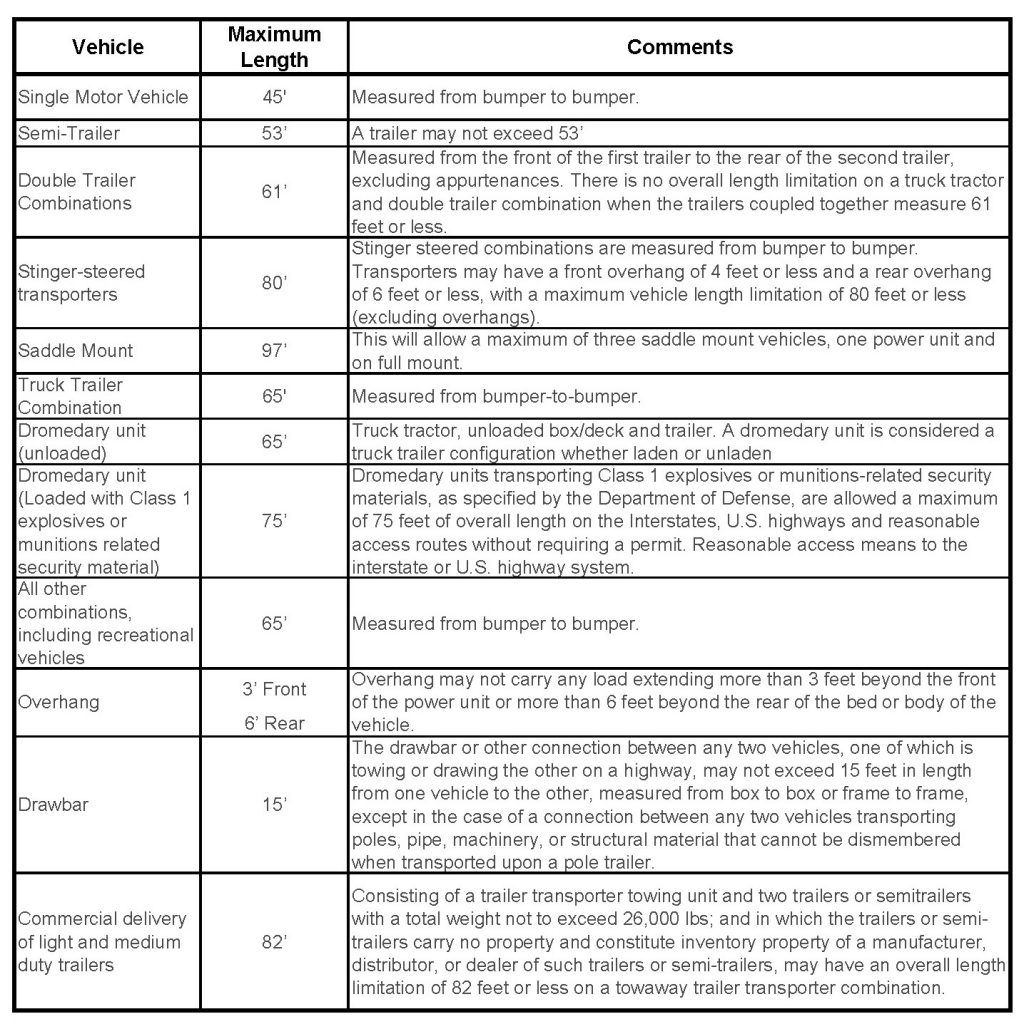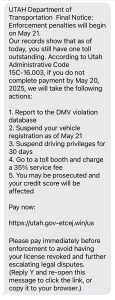Legal Height, Width, & Length
HEIGHT, WIDTH, & LENGTH
Utah Administrative Rule R909-2-4
The following are the maximum legal vehicle dimensions, loaded or unloaded, that may be operated without special permits on Utah highways:
Height: 14′
Measured from level road surface to top of load or vehicle.
Width: 8′ 6″
With or without load. Measured from outside to outside of widest extremities, excluding appurtenant devices as referenced in UCA 72-7-402(1).
Length: Maximum lengths for various vehicles can be found in Utah Administrative Rule R909-2-4
DEFINING AND MEASURING
Defining and Measuring Legal Height: Commercial vehicles may operate within the legal height dimension of 14 feet. This is determined by measuring from the surface of the roadway to the highest point on the load or vehicles.
Defining and Measuring Legal Width: Commercial vehicles may operate within the legal width dimension of 8 feet 6 inches. This is determined by measuring from the widest points on each side of the vehicle or load.
Defining and Measuring Legal Length (examples can be see by clicking on each type of vehicle) :
Single Unit Motor Vehicle: A single motor vehicle is a power unit that is not towing or pulling another vehicle. These vehicles may not exceed 45 feet in length. This is determined by measuring from the front-most point of the vehicle to the rear-most point of the vehicle, excluding overhangs. In most cases, this would be measured from front bumper to rear bumper.
Semi-Trailer or Full Trailer Combinations: Semi trailers or full trailers are vehicles that cannot be moved under their own power and are designed to carry a load while being drawn behind a power unit.The legal length for semi-trailer is 53 feet. The legal length for a full trailer is 48 feet. This is determined by measuring from the front most point of the trailer to the rear most point of the trailer and should not include any cargo with the measurement.
Note: There is no overall length limitation on a tractor and semi-trailer combination when the trailer length is 53 feet or less.
Truck Trailer Combinations: A Truck Trailer Combination is allowed up to 65 feet of overall length. This is determined by measuring from the front bumper of the truck to the rear bumper of the trailer, including the drawbar or connecting devices. Front and rear overhangs are not included in the overall length.
Rear Overhang: Determined by measuring from the rear or body of the vehicle or from the center of the closest axle in the absence of bumper/bed of vehicle.
Front Overhang: Determined by measuring from the front of the power unit.
Double Trailer Combinations: A double trailer combination consisting of a tractor and two trailers may have a combined trailer length up to 61 feet. This is determined by measuring from the front of the lead trailer to the back of the rear trailer including the connecting equipment. This measurement is referred to as cargo carrying length. There is no overall length limit for a tractor and double trailer combination when the trailers coupled together measure 61 feet or less.
Stinger-Steered Transporters: Stinger-steered transporters are considered specialized equipment and have been given additional length allowances by the Federal Highway Administration. These additional length allowances are only available when transporting automobiles, boats, or camp trailers, and may include a load of general freight on the backhaul.A stinger-steered transporter is a truck and trailer combination where the fifth wheel is located on a drop frame behind and below the rear most axle of the power unit. These units are most recognized as auto or boat transporters.
The legal length of a stinger-steered transporter is 80 feet measured from bumper to bumper. These combinations are allowed to have an additional 4 feet of front overhang and 6 feet of rear overhang. To determine proper measuring points on these combinations when extendable ramps or flippers are used and to ensure consistency and uniformity within the Division, measurements will be taken as follows:
- The cargo carrying length of 80 feet is measured from the front bumper of the power unit rearward to the rear bumper of the trailer. When flippers or ramps are used, and the front bumper of the power unit to rear bumper of the trailer measurement is less than 80 feet, the measurement will be taken from the front bumper rearward 80 feet.
Note: This 80 foot point may extend beyond the rear bumper of the trailer and be located within the extended ramp or flipper.
The 4 feet of front overhang is measured from the front bumper of the power unit to the end of the overhang.
The 6 feet of rear overhang is measured from the rear bumper of the trailer to the end of the overhang, or from the 80 foot point on the flipper or ramp to the end of the overhang.
The total overall length allowed including overhangs with or without ramps or flippers may not exceed 90 feet.
Note: Stinger steered combinations exceeding 4 feet of front overhang, 6 feet of rear overhang, and 90 feet of overall length will not be permitted, and corrective action will be necessary before returning to the highway. Corrective actions may include but are not limited to shifting or removing vehicles.
Saddle Mount Combinations: A saddle mount configuration consists of a truck or tractor transporting up to four additional trucks, tractors, or vehicles. You should note that the industry may refer to this configuration as a “piggy back” unit. The additional trucks or tractors are connected by a saddle to the frame or 5th wheel of the power unit or preceding vehicle. A saddle mount configuration is legal up to 97 feet overall length and may consist of:
- The power unit
- No more than three saddle mounted vehicles, and/or
- One fully mounted vehicle loaded without any part touching the road surface.
- To determine legal dimensions, measure from the front bumper of the power unit to the rear most point of the last vehicle.
Dromedary Units: A dromedary is a box, deck, or plate mounted behind the tractor’s cab and forward of the fifth wheel on its frame. Truck tractor, unloaded box/deck and trailer. A dromedary unit is considered a truck trailer configuration whether laden or un-laden.
Exception: Dromedary units transporting Class 1 explosives or munitions-related security materials, as specified by the Department of Defense, are allowed up to 75 feet of overall length on the Interstates, U.S. highways and reasonable access routes without requiring a permit. Reasonable access means any other highway that facilitates access to the Interstate or U.S. highway system.
Commercial Delivery of Light- and Medium-Duty Trailers: Consisting of a trailer transporter towing unit and 2 trailers or semi-trailers with a total weight not to exceed 26,000 lbs.; and which the trailers or semi-trailers carry no property and constitute inventory property of a manufacturer, distributor, or dealer of such trailers and semi-trailers, may have an overall length of 82 feet on a towaway trailer transporter combination. Measured from the front of the first vehicle to the back of the rearmost vehicle.
All Other Combinations: All other configurations not defined above are considered to be “other combinations.” Maximum legal length for “other combinations” is 65 feet. This is determined by measuring from the front of the first vehicle, to the back of the rear most vehicle within the combination including connecting devices.
Exception: Appurtenances attached to the sides or rear of a recreational vehicle (non-commercial), are excluded for the purposes of measuring width and length, provided the additional width or length does not exceed 6 inches such as door handles, light fixtures and awnings.

Drawbar in excess of 15′ shall be required to obtain an oversize permit when exceeding legal limits.
Note: When measuring a drawbar length on vehicles that have the coupling device, hitch mounted on the end of the box, bed or frame, do not include the coupling device/hitch in the measurement. An example of this would be a drawbar that when not attached to a tow vehicle, does not exceed 15 feet but when attached to the towing vehicle, the distance from frame to frame or box to frame is greater than 15 feet as a result of the coupling device/hitch.
TRUCK TRACTOR SEMI-TRAILER COMBINATIONS
Exception: When measuring a vehicle to determine legal dimensions, do not include appurtenances. Appurtenances include the following:
- Refrigerator units
- Hitches
- Air line connections
- Load securing devices
Note: This exception does not apply to devices designed or used to carry cargo.



